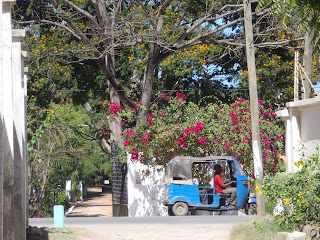It is hard to believe that I have already been in Tanzania now for two months (1 ½ at the field site), and that in just a few days it will be 2011. The new year looks like it will be an interesting and exciting one, hopefully filled with lots of data :)
Progress with my research started slow, but things have been turning around lately, and I now already have some really good data in addition to some amazing photos from the camera traps (I wish I could share some with you here, but they are the property of many people, not just myself, so publishing them on a blog at this point is not possible). I have encountered many kinds of animals here: bush duikers, bushbuck, bushpigs, mongooses, hornbills, turacos, baboons….I have even had some glimpses of the chimpanzees, although they like to make a habit of not staying around for very long. My most exciting “animal story” is actually not mine, but that of one of my field assistants. We were observing one of my patches when we heard the baboons alarm calling and barking from a few hundred meters away. After one hour they were still at it, so my field assistant went to go check it out. He came back very quickly announcing that he had seen a leopard! Apparently it was looking to make a snack out of one of the baboons, but ran away when it saw my field assistant approaching. He saw the leopard and high-tailed it out of there. Now we are always on the lookout for the leopard when passing that spot, but as of yet there have been no further sightings.
I am slowly getting used to the daily treks up and down the mountainous terrain to and from my patches, but am still going to bed each night completely exhausted and sore from head to toe. One thing is for sure, I will be in very good physical shape by the time I leave here! Climbing up and down mountains each day has also made me come to the conclusion that bipeds are not meant to live in such an environment; whether going up or down you are often forced to lower your center of mass (i.e. get on your hands and knees) to fight the pull of gravity. I can offer up the many (small) bruises, scratches, and bumps that I have as evidence for this conclusion!
I’m afraid that this entry will have to be a short one, as I am running out of time (and therefore internet usage) here in town. I will leave you with some photos of animals that I took with my own camera.
I hope that you all had a wonderful holiday season and that you all have a happy and healthy New Year!!














